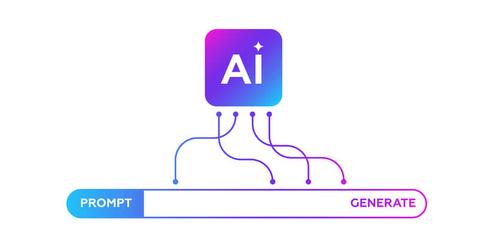Artificial intelligence (AI) is software that carries out tasks traditionally requiring human judgment. In practice, it functions as a digital assistant that automates repetitive tasks and provides useful results in seconds.
If you think AI isn’t for builders, are too busy to look into this new technology, or consider yourself a tech novice, think again.
Why use AI for small building companies
With tight margins and evenings vanishing under mountains of paperwork, AI provides small and medium-sized builders a way to reclaim time and sharpen their competitive edge, without hiring extra office staff or investing in expensive business software.
Think of AI as a quick, clever employee who never sleeps – drafting quotes, writing social posts, juggling schedules, and spotting project risks before they cost you money.
Some of the UK’s largest construction firms, such as Balfour Beatty, Bechtel, and McAlpine, already use AI to organise their businesses. However, AI isn’t just for industry giants, many of our members are also AI users. For more tips on streamlining and scaling your business, join our community.
AI jargon buster
- Chatbot: AI software that simulates human-like conversations with customers.
- Computer vision: AI that “sees” site photos or CCTV, flags missing PPE or measures progress without a tape measure.
- Fine-tuning: Feeding the AI your past quotes or site diaries so its future outputs match your pricing and tone.
- Generative AI: Tools that create fresh content – drafting quotes, safety checklists or even 3D visuals, rather than just analysing data.
- Hallucination: When AI fabricates an answer, e.g., a wrong regulation. Always double-check critical details.
- Machine learning (ML): The way AI “studies” previous jobs and costs so it can predict new ones without you spelling out every rule.
- Prompt: The instruction you type, e.g., “Write a polite payment reminder for a £4,200 invoice, 150 words max.” The clearer the prompt, the better the result.
- Take-off automation: AI that scans drawings/PDFs, counts bricks, beams and boards, then builds your material list in minutes.
How to start using AI in construction step by step
If you can text, you can use AI to streamline and grow your business – it really is that easy. Follow our step-by-step beginner AI guide for builders and see the difference.
1. Identify the time-eaters
Start by listing the office chores that steal your evenings and weekends – quotes, client emails, scheduling, social media posts, and so on. Circle the worst offender, and that’s your first AI target. If you’re unsure, track your admin hours for one week.

2. Choose the best AI apps for construction
AI for small building companies doesn’t need to cost the earth, and there are numerous apps to choose from, with new, easy-to-use AI tools for trades being regularly released. Utilise freemium plans and free trials to determine which apps best suit your needs and purpose, but stick to using one at a time for clarity.
| Purpose | Suggested AI app | Typical monthly cost* |
|---|---|---|
| Quotes and take-offs | Buildxact’s AI Estimator Calculator, Kreo | £50 |
| Content and communication | ChatGPT, Jasper | £20 |
| Project planning | Trello with AI Add-On, BuildAI | £15 |
| Site safety | Buildots, Safesite AI | £15 |
* If prices are listed in US dollars, you may need to manually input VAT. Many AI apps offer freemium packages, free trials, or reduced annual prices
3. Gather a fine-tuning pack
Export a handful of recent quotes, emails or schedules – anonymised if they mention clients, into a folder. These examples help the AI app understand your pricing style, tone of voice and typical job sizes, enabling it to produce the required results.
4. Write a crystal-clear prompt
Remember, the clearer your prompt is, the better your results will be. If you’re used to writing briefs for subcontractors, this is a good place to start from. For example:
- Context: “We’re a family-run builder in Bristol.”
- Task: “Draft a polite payment reminder for a £4,200 loft-conversion invoice that’s 14 days overdue.”
- Format: “150 words max, friendly but firm, sign off from Dave.”
ChatGPT’s response:
Subject: Friendly payment reminder – Invoice #1234 (14 days overdue)
Hi [Client name],
I hope you’re enjoying the new loft space. I’m writing to remind you that invoice 1234 for £4,200, issued on [date], is now 14 days past its due date. As a small, family-run firm, we rely on prompt payments to keep projects running smoothly, so I’d be grateful if you could arrange settlement this week.
Our bank details are on the original invoice; let me know if you need a copy or have any questions about the work.
Thanks for your attention, and I look forward to hearing from you.
Best regards,
Dave
[Company name]
This result took a second or two to produce, and after checking it over for errors, it’s ready to copy and paste into an email and send. However, you can ask AI to change the copy until it feels right, e.g., “shorten/lengthen,” “make it more casual/formal,” or “add bullet points.”
Save your best prompts on your laptop, and next time, they’re just one copy/paste away.

5. Check your results
Whether you’re using AI for quotes, planning, or health and safety issues, it’s essential to check for errors. While AI is a game changer for the construction industry, mistakes do happen and can prove costly, so always double-check data points, current regulations, and any other relevant information.
6. Run a one-project pilot
Apply the AI tool to a live job, logging the minutes saved, errors caught, or leads generated, and compare it to your manual process. This will provide the evidence you need to move forward or consider your options.
7. Review, tweak and scale
Hopefully, your results will be successful, and you can roll out the AI tool to more projects, unlock paid features, and look at apps designed for other time-consuming tasks.
If you can’t see a clear improvement in time or money management, you may need to look for a different app, refine your prompts, or be more selective when choosing the tasks that AI is employed for.
FAQs about AI for small building companies
Does AI software support mobile access for on-site teams?
Most leading AI construction software offers dedicated iOS/Android apps, allowing site teams to capture data, view tasks, and receive AI-powered alerts directly on their phones.
Is my data safe?
If you choose reputable AI tools with UK/EU data centres, ISO 27001/SOC 2 certification, encryption, and an opt-out from model training, your data is as safe as with any compliant cloud service; just apply the same GDPR checks and access controls you’d use for other software.
Will AI take over construction?
No. For admin tasks and phases of project development, AI is an efficient and cost-effective tool; however, it won’t replace people on the jobsite. Human experience and judgment are integral parts of the construction industry.
AI is no longer a luxury reserved for major contractors – it’s a practical, low-cost tool that small building companies can start using today to cut admin hours, sharpen estimates and keep projects on track. Try it and you’ll quickly see why even non-tech-savvy builders are calling AI the best new addition to the toolbox.



